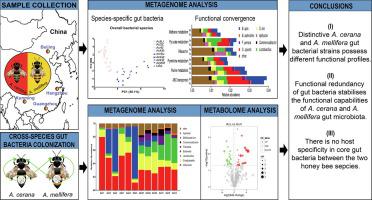Journal of Advanced Research ( IF 10.7 ) Pub Date : 2021-08-10 , DOI: 10.1016/j.jare.2021.08.002 Yuqi Wu 1 , Yufei Zheng 1, 2 , Shuai Wang 1 , Yanping Chen 3 , Junyi Tao 4 , Yanan Chen 1 , Gongwen Chen 1 , Hongxia Zhao 5 , Kai Wang 6 , Kun Dong 7 , Fuliang Hu 1 , Ye Feng 2, 8 , Huoqing Zheng 1

|
Introduction
The functional relevance of intra-species diversity in natural microbial communities remains largely unexplored. The guts of two closely related honey bee species, Apis cerana and A. mellifera, are colonised by a similar set of core bacterial species composed of host-specific strains, thereby providing a good model for an intra-species diversity study.
Objectives
We aim to assess the functional relevance of intra-species diversity of A. cerana and A. mellifera gut microbiota.
Methods
Honey bee workers were collected from four regions of China. Their gut microbiomes were investigated by shotgun metagenomic sequencing, and the bacterial compositions were compared at the species level. A cross-species colonisation assay was conducted, with the gut metabolomes being characterised by LC-MS/MS.
Results
Comparative analysis showed that the strain composition of the core bacterial species was host-specific. These core bacterial species presented distinctive functional profiles between the hosts. However, the overall functional profiles of the A. cerana and A. mellifera gut microbiomes were similar; this was further supported by the consistency of the honey bees’ gut metabolome, as the gut microbiota of different honey bee species showed rather similar metabolic profiles in the cross-species colonisation assay. Moreover, this experiment also demonstrated that the gut microbiota of A. cerana and A. mellifera could cross colonise between the two honey bee species.
Conclusion
Our findings revealed functional differences in most core gut bacteria between the guts of A. cerana and A. mellifera, which may be associated with their inter-species diversity. However, the functional profiles of the overall gut microbiomes between the two honey bee species converge, probably as a result of the overlapping ecological niches of the two species. Our findings provide critical insights into the evolution and functional roles of the mutualistic microbiota of honey bees and reveal that functional redundancy could stabilise the gene content diversity at the strain-level within the gut community.



























 京公网安备 11010802027423号
京公网安备 11010802027423号